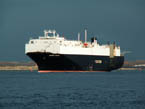In the globalized world, international trade has become an integral part of the economy. The transportation of goods across borders plays a crucial role in this process. One of the most common methods of shipping goods is through container transportation. This article will discuss two popular shipping options: full container load (FCL) and less than container load (LCL).
Firstly, let's understand the concept of a container. A container is a large, standardized metal box designed to facilitate the transportation of goods. These containers are loaded onto ships, trucks, or trains, making it easier to transport goods from one location to another. Containers come in various sizes, with the most common being 20 feet and 40 feet long.
Now, let's delve into the two types of container shipping: FCL and LCL.
Full Container Load (FCL) shipping is when an entire container is filled with goods from a single shipper. This method is ideal for businesses that have a large volume of goods to ship. FCL shipping offers several advantages:
1. Cost-effectiveness: Since the entire container is filled with the shipper's goods, the shipping cost per unit is lower compared to LCL shipping.
2. Security: FCL shipping provides a higher level of security, as the goods are not mixed with those of other shippers.
3. Efficiency: FCL shipping is faster and more efficient, as the container is loaded and unloaded only once.
4. Flexibility: Shippers can choose from various container sizes, depending on their needs.
However, there are some drawbacks to FCL shipping:
1. High minimum order quantity: Shippers need to have a large volume of goods to fill an entire container.
2. Limited flexibility: If the shipper's goods do not fill the container, they will have to pay for the unused space.
On the other hand, Less Than Container Load (LCL) shipping is when goods from multiple shippers are consolidated into one container. This method is suitable for businesses with a smaller volume of goods to ship. LCL shipping offers the following benefits:
1. Cost-effectiveness: LCL shipping is more affordable, as the shipping cost is shared among multiple shippers.
2. Flexibility: Shippers can ship smaller quantities of goods without the need for a full container.
3. Accessibility: LCL shipping is available at most ports and shipping companies.
However, LCL shipping also has its downsides:
1. Security concerns: Since goods from multiple shippers are consolidated in one container, there is a higher risk of theft or damage.
2. Longer transit times: LCL shipping is slower than FCL shipping, as the container needs to be consolidated and unloaded multiple times.
3. Limited control: Shippers have less control over the handling and storage of their goods during transit.
In conclusion, both FCL and LCL shipping have their advantages and disadvantages. The choice between the two depends on the shipper's specific needs, such as the volume of goods, budget, and desired level of control over the shipping process.
For businesses with a large volume of goods, FCL shipping is the preferred option due to its cost-effectiveness, security, and efficiency. However, for businesses with a smaller volume of goods, LCL shipping is a more affordable and flexible alternative.
As the global economy continues to grow, the demand for container shipping is expected to increase. Shippers must carefully consider their shipping options to ensure that their goods are transported safely, efficiently, and cost-effectively. Whether it's FCL or LCL shipping, understanding the differences and choosing the right method is crucial for the success of international trade.

——END——
https://www.fanjue56.com/guojihuodai/92628.html,以上就是海运整柜和拼柜英文的解读,只要通过预约方式联系我们的顾问客服根据不同进口产品, 即可获得国际货运方案和进口报关代理报价单,手续费低,省钱,省心。工作人员看到您的信息会第一时间与您联系,文章图文源于网络和投稿、即编辑排版,传递更多知识,如涉及版权,请及时联系我们会尽快处理。如果您还有其他疑问,欢迎致电400-0031-521.

